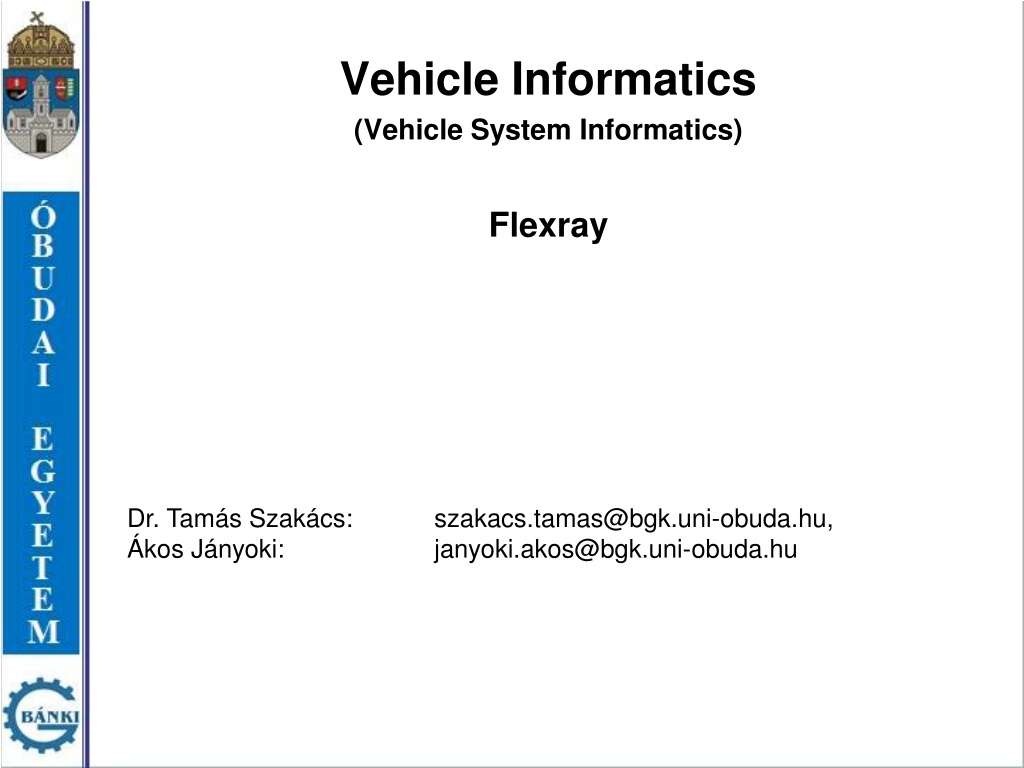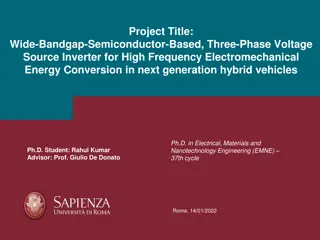
FlexRay Communication System in Vehicle Informatics
"Explore the advanced FlexRay communication system for high-speed control applications in vehicles, offering deterministic and fault-tolerant data transmission with support for distributed control systems. Learn about FlexRay's goals, features, hardware setup, and more." (248 characters)
Download Presentation

Please find below an Image/Link to download the presentation.
The content on the website is provided AS IS for your information and personal use only. It may not be sold, licensed, or shared on other websites without obtaining consent from the author. Download presentation by click this link. If you encounter any issues during the download, it is possible that the publisher has removed the file from their server.
E N D
Presentation Transcript
Vehicle Informatics (Vehicle System Informatics) Flexray Dr. Tam s Szak cs: kos J nyoki: szakacs.tamas@bgk.uni-obuda.hu, janyoki.akos@bgk.uni-obuda.hu
FlexRay Advanced Automotive Communication System Outline: Scalable static and dynamic message transmission (deterministic and flexible) High net data rate of 5 Mbit/sec; gross data rate approximately 10Mbit/sec Scalable fault-tolerance (single and dual channel) Error containment on the physical layer through an independent Bus Guardian Fault tolerant clock synchronisation (global time base)
FlexRay Motivation Demand for a bus system with high data rate Deterministic and fault tolerant bus system for advanced automotive control applications Support from the bus system for distributed control systems Limited number of different communication systems within vehicles FlexRay requirements MOST CAN LIN control systems telematics
FlexRay Goals Develop an advanced communication technology for high-speed control applications in vehicles Make the technology available in the market place for everyone Drive the technology as a defacto standard
FlexRay Basic Features Synchronous and asynchronous data transmission (scalable) High net data rate of 5 Mbit/sec; gross data rate approximately 10Mbit/sec Deterministic data transmission, guaranteed message latency and message jitter Support of redundant transmission channels Fault tolerant and time triggered services implemented in hardware Fast error detection and signalling Support of a fault tolerant synchronised global time base Error containment on the physical layer through an independent Bus Guardian Arbitration free transmission Support of optical and electrical physical layer Support for bus, star and multiple star topologies
FlexRay Hardware Features and Topology of a Distributed FlexRay System - Active Star Optional redundant communication channels 1 to 1 communication connections in combination with active stars Support of wake-up via bus Support of net data rates up to 5 Mbit/sec Support of power management Communication Controller and C Bus Driver Physical 1 to 1 Communication Connection Active Star Redundancy ECU
FlexRay Hardware Features and Topology of a Distributed FlexRay System - Passive Bus Solution with restrictions (reuse of available Physical Layer): Optional redundant communication channels Support of wake-up via bus, depends on the Physical Layer low gross data rate (similar to CAN) Support of power management, depends on the Physical Layer Bus Guardian, depends on the Physical Layer
FlexRay Features and Block Diagram of a FlexRay ECU Permanent Power 1 or 2 bus drivers connected to one communication controller Connection to permanent power ECU Wake-up via bus Microcontroller (Host) Shut-down by the ECU Power Supply Communication Controller Power modes of nodes Level 1 Level 2 Level 3 Communication Power supply (internal) available available unavailable Guardian Guardian Bus Driver Bus Driver Bus Bus available unavailable unavailable Bus Bus
FlexRay Features and Block Diagram of a FlexRay Active Star More than 1 bus driver required Permanent Power Communication controller and micro controller are not required Connection to permanent power Active Star Wake-up via bus Power Supply Shut-down via bus Bus Driver Bus Driver Power modes of an active star Level 1 Level 2 Level 3 Communication Power supply (internal) available available unavailable Bus Bus available unavailable unavailable
FlexRay Data Transmission node B node C node D node E node F node G node A channel 1 sync symbol channel 2 messages channel 1 12 1314 15 10 11 3 6 7 2 4 8 1 5 0 9 slot frame (static part) ID datatype node 11 12 14 15 1 2 3 4 5 6 7 9 ... dm do dq dl dg da db dc dd de df dk A A F E A messages channel 2 B C B D E F C 13 12 10 11 8 slot 3 6 7 9 2 4 1 5 0 1415 frame 9 12 13 11 4 5 1 2 3 8 ... (dynamic part) ID datatype node dp dn d d d e dj d a dh di d k d l G A A B D A B C G C static part dynamic part communication cycle
FlexRay FlexRay Protocol Frame Format (I) ID MUX SYNC LEN DATA CRC 10 bit 4 bit 0...12 byte 16 bit 1 bit 1 bit Identifier, 10 bit, range: (110... 102310), defines the slot number in the static part or the priority in the dynamic part ID: Multiplex Field, 1 bit, enables a node to transmit different messages with the same ID MUX: Synchronisation Field, 1 bit, tags the frames which will be used for the clock synchronisation SYNC: Length field, 4 bit, LEN = number of used data bytes (010... 1210) LEN: D0 ... D11:Data bytes, 0-12 bytes Cyclic Redundancy Check Field, 16 bit CRC:
FlexRay FlexRay Protocol Frame Format (II) ID MUX SYNC LEN DATA CRC CYCLE 10 bit 4 bit 8 bit 0...11 byte 16 bit 1 bit 1 bit The cycle counter will be used to synchronise application processes which are longer as the communication cycle. Cycle Counter, 8 bit, range: (010... 25510). The CYCLE-field will be used as cycle counter or as a data byte. The cycle counter will be incremented consistently in all communication controllers at the beginning of each communication cycle CYCLE: Synchronisation field, 1 bit, tags the frames which contain the cycle counter SYNC: D0 ... D10: Data bytes, 0-11 bytes
FlexRay FlexRay Protocol Clock Synchronisation Synchronisation of the local clocks to a global time base Up to two asymmetric faults can be tolerated if there are a sufficient number of nodes Fault tolerant clock synchronisation is available in a pure static configuration and in a mixed configuration (static and dynamic part in the communication cycle) No fault tolerant clock synchronisation is available in a pure dynamic configuration Support of all topologies (single channel, dual channel, mixed single and dual channel) Only nodes in the static part can participate in the clock synchronisation (with frames which are tagged with the SYNC bit) All nodes can use the global time
Why Time-Triggered Protocol Market Trends in the information society Computerized components for mechanical engineering Aircraft domain (Airbus A320) Who can make it possible for cost-sensitive industry? Automobile, industrial control, and so on TTTech Time Triggered Technology Offer products for evaluation and design of TTP-based system TimeTriggeredProtocol.ppt
TTP (Time-Triggered Protocol) TTP more than just a protocol Network protocol Operating system scheduling philosophy Fault tolerance approach Time-Triggered approach Stable time base Simple to implement the usual stuff Cyclic schedules TimeTriggeredProtocol.ppt
Two derivation TTP/A (Automotive Class A = soft real time) A scaled-down version of TTP A cheaper master/slave variant TTP/C (Automotive Class C = hard real time) A full version of TTP A fault-tolerant distributed variant TimeTriggeredProtocol.ppt
TTP/A: A reduced cost version For example: How do you do this for about $2 per node? Answer: after making compromises, and use on Class A devices (soft real time) Distributed fault tolerance is expensive (especially time bases), so go master/slave polling instead TimeTriggeredProtocol.ppt
Protocol Layer in TTP/A TimeTriggeredProtocol.ppt
Polling Operation Master polls the other nodes (slaves) Non-master nodes transmit messages when they are polled Inter-slave communication through the master TimeTriggeredProtocol.ppt
Poll Tradeoff Advantage Simple protocol to implement Historically very popular Bounded latency for real-time applications Disadvantage Single point of failure from centralized master Polling consumes bandwidth Network size is fixed during installation(or master must discover nodes during reconfiguration) TimeTriggeredProtocol.ppt
TTP/C TTP/C A time-triggered communication protocol for safety-critical (fault-tolerant) distributed real- time control systems Based on a TDMA(Time Division Multiple Access) media access strategy Based on clock synchronization TimeTriggeredProtocol.ppt
TTP/C Some Concepts CNI Communication Network Interface: interface between communication controller and the host computer within a node of a distributed system Composability various components of a software system can be developed independently and integrated at a late stage of software development Fail Silence A subsystem is fail-silent if it either produces correct results or no results at all, i.e., it is quiet in case it cannot deliver the correct service FTU Fault-Tolerance Unit SRU Smallest Replaceable Unit TimeTriggeredProtocol.ppt
TTP/C Protocol Layer Application software in Host Host Layer FTU CNI FTU Layer FTU Membership Basic CNI RM Layer Redundancy Management SRU Membership SRU Layer Clock Synchronization Data Link/Physical Layer Media Access: TDMA TimeTriggeredProtocol.ppt
(Contd.) Data Link/Physical Layer Provide the means to exchange frames between the nodes SRU Layer Store the data fields of the received frames RM Layer Provide the mechanisms for the cold start of a TTP/C cluster FTU Layer Group two or more nodes into FTUs Host Layer Provide the application software Basic CNI A data-sharing interface between the RM layer and FTU layer FTU CNI The interface between FTU layer and Host Layer TimeTriggeredProtocol.ppt
Objectives in TTP/C Precise Interface Specifications Composability Reusability of Components Improved Supplier/Sub-supplier Relationship Timeliness Error Containment Constructive Testability Seamless Integration of Fault-Tolerance Simpler Application Software Shorter Time-to-Market Reduced Development Costs Reduced Maintenance Costs TimeTriggeredProtocol.ppt
Structure of TTP/C System TimeTriggeredProtocol.ppt
FTU in TTP/C FTU Configuration Examples (a) Two active nodes, two shadow nodes (b) Three active nodes with one shadow nodes (Triple modular Redundancy) (c) Two active nodes without a shadow node TimeTriggeredProtocol.ppt
Single Node Configuration Includes controller to run protocol DPRAM (dual ported RAM) To implement memory-mapped network interface BG (Bus Guard) Hardware watchdog to ensure fail silent Real chips must use highly accurate time sources Even dual redundant crystal oscillators as used in DATAC for Boeing 777) TimeTriggeredProtocol.ppt
TTP/C Single Node Configuration TimeTriggeredProtocol.ppt
Cycle in TTP/C TDMA Cycle One FTU sends results twice Then next FTU sends some results And so on, until back to the next message from the first FTU Cluster Cycle Cluster cycle involves scheduling all possible message and tasks TimeTriggeredProtocol.ppt
TTP/C Frame I-Frames used for initialization N-Frames used for normal messages TimeTriggeredProtocol.ppt
Pros and Cons of TTP Advantage Simple protocol to implement Deterministic response time No wasted time for Master polling message Disadvantage Single point of failure from the bus master Wasted bandwidth when some nodes are idle Stable clocks Fixed network size during installation TimeTriggeredProtocol.ppt
A comparison TTP/A vs. TTP/C TTP/A TTP/C Service Central Multimaster Distributed, Fault-Tolerant Clock Synchronization Mode Switches yes yes Communication Error Detection Parity 16/24 bit CRC Membership Service simple full External Clock Synchronization yes yes Time-Redundant Transmission yes yes Duplex Nodes no yes Duplex Channels no yes Redundancy Management no yes Shadow Node no yes
TTP/C + TTP/A TTP/A is intended for low cost TTPnode implements such an integrated TTP/C and TTP/A solution to carry out all sensing and actuating action within hard real-time deadlines and minimal jitter (Jitter: The jitter is the difference between the maximum and the minimum duration of an action (processing action, communication action) ) TimeTriggeredProtocol.ppt
TTTech Time Triggered Technology TTTech Evaluation Cluster -- TTP Hardware Systems TTP Hardware Products TTPnode TTP Software Products TTP tools TTPplan TTPbuild TTPos TTPView TTPload TimeTriggeredProtocol.ppt
(Contd.) TTPplan A comprehensive tool for the design of TTP clusters based on the concepts of state messages and temporal firewalls TTPbuild An environment for the design of nodes in a TTP cluster TTPos The Time-Triggered Architecture and the TTP/C communication protocol, with fault-tolerance TTPview An easy-to-use graphical user interface which monitors the real-time messages among nodes TTPload An easy-to-use graphical user interface which allows to create and maintain download collections
TTP Demonstration Specification Controller and cluster communication startup Basic communication with TTP/C Basic FT layer features like host lifesign and message handing Building a replica determinate task Re-integration of a replica using h-state messages Checking the current degree of redundancy of a message Reacting to sporadic events in a time-triggered architecture

